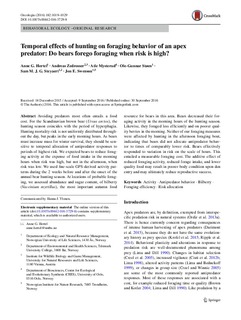| dc.contributor.author | Hertel, Anne Gabriela | |
| dc.contributor.author | Zedrosser, Andreas | |
| dc.contributor.author | Mysterud, Atle | |
| dc.contributor.author | Støen, Ole-Gunnar | |
| dc.contributor.author | Steyaert, Sam | |
| dc.contributor.author | Swenson, Jon | |
| dc.date.accessioned | 2018-06-07T09:01:30Z | |
| dc.date.available | 2018-06-07T09:01:30Z | |
| dc.date.created | 2016-11-16T10:36:52Z | |
| dc.date.issued | 2016 | |
| dc.identifier.citation | Oecologia. 2016, 182 (4), 1019-1029. | nb_NO |
| dc.identifier.issn | 0029-8549 | |
| dc.identifier.uri | http://hdl.handle.net/11250/2500745 | |
| dc.description.abstract | Avoiding predators most often entails a food cost. For the Scandinavian brown bear (Ursus arctos), the hunting season coincides with the period of hyperphagia. Hunting mortality risk is not uniformly distributed throughout the day, but peaks in the early morning hours. As bears must increase mass for winter survival, they should be sensitive to temporal allocation of antipredator responses to periods of highest risk. We expected bears to reduce foraging activity at the expense of food intake in the morning hours when risk was high, but not in the afternoon, when risk was low. We used fine-scale GPS-derived activity patterns during the 2 weeks before and after the onset of the annual bear hunting season. At locations of probable foraging, we assessed abundance and sugar content, of bilberry (Vaccinium myrtillus), the most important autumn food resource for bears in this area. Bears decreased their foraging activity in the morning hours of the hunting season. Likewise, they foraged less efficiently and on poorer quality berries in the morning. Neither of our foraging measures were affected by hunting in the afternoon foraging bout, indicating that bears did not allocate antipredator behavior to times of comparably lower risk. Bears effectively responded to variation in risk on the scale of hours. This entailed a measurable foraging cost. The additive effect of reduced foraging activity, reduced forage intake, and lower quality food may result in poorer body condition upon den entry and may ultimately reduce reproductive success. | nb_NO |
| dc.language.iso | eng | nb_NO |
| dc.rights | Navngivelse 4.0 Internasjonal | * |
| dc.rights.uri | http://creativecommons.org/licenses/by/4.0/deed.no | * |
| dc.title | Temporal effects of hunting on foraging behavior of an apex predator: Do bears forego foraging when risk is high? | nb_NO |
| dc.type | Journal article | nb_NO |
| dc.type | Peer reviewed | nb_NO |
| dc.description.version | publishedVersion | nb_NO |
| dc.rights.holder | The Author(s) 2016. | nb_NO |
| dc.source.pagenumber | 1019-1029 | nb_NO |
| dc.source.volume | 182 | nb_NO |
| dc.source.journal | Oecologia | nb_NO |
| dc.identifier.doi | 10.1007/s00442-016-3729-8 | |
| dc.identifier.cristin | 1400910 | |
| dc.relation.project | Norges forskningsråd: 179569 | nb_NO |
| cristin.unitcode | 222,58,1,0 | |
| cristin.unitname | Institutt for natur, helse og miljø | |
| cristin.ispublished | true | |
| cristin.fulltext | original | |
| cristin.qualitycode | 1 | |

